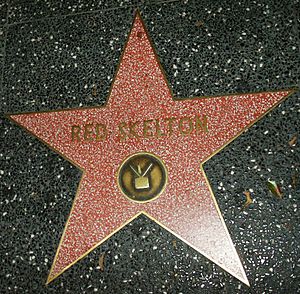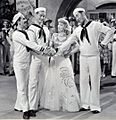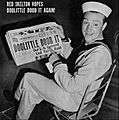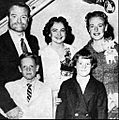Red Skelton facts for kids
Quick facts for kids
Red Skelton
|
|
|---|---|
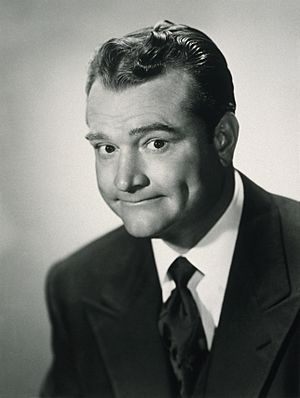
Skelton in 1960
|
|
| Born |
Richard Red Skelton
July 18, 1913 Vincennes, Indiana, U.S.
|
| Died | September 17, 1997 (aged 84) |
| Resting place | Forest Lawn Memorial Park, Glendale, California, U.S. |
| Occupation | Actor, artist, comedian |
| Years active | 1923–1993 |
| Spouse(s) |
Edna Marie Stillwell
(m. 1931; div. 1943)Georgia Davis
(m. 1945; div. 1971)Lothian Toland
(m. 1973) |
| Children | 2 |
Richard Red Skelton (born July 18, 1913 – died September 17, 1997) was a famous American entertainer. He was best known for his popular radio and television shows. These shows ran from 1937 to 1971. His most famous was The Red Skelton Show on TV.
Red Skelton has two stars on the Hollywood Walk of Fame. One is for his radio work and the other for his TV shows. He also performed in many other ways. He was in burlesque (a type of comedy show), vaudeville (variety shows), movies, nightclubs, and casinos. Besides all this, he was also a talented artist.
Contents
Early Life and Comedy Beginnings
Red Skelton started learning comedy and pantomime (acting without words) when he was just 10 years old. He joined a traveling "medicine show." These shows would travel around selling fake medicines and putting on performances. After that, he worked on a showboat (a boat with a theater). Then he performed in burlesque and vaudeville shows.
In 1934, he started in vaudeville. He and his wife wrote a funny pantomime act called "Doughnut Dunkers." This act helped him become famous in vaudeville, on radio, and in movies.
Radio and Film Career
Red Skelton's radio career began in 1937. He was a guest on a show called The Fleischmann's Yeast Hour. This led to him hosting Avalon Time in 1938. In 1941, he became the host of The Raleigh Cigarette Program. On this show, he created many of his famous comedy characters. He had his own radio show until 1957.
Skelton also became a movie star. His first film was in 1938, called Having Wonderful Time. He appeared in many musical and comedy movies in the 1940s and 1950s. He had main roles in 19 films. Some of these include Ship Ahoy (1941), I Dood It (1943), Ziegfeld Follies (1946), and The Clown (1953).
Television Success
Red Skelton was very excited to work in television, even when it was a new thing. The Red Skelton Show first aired on September 30, 1951, on NBC. In 1954, his show moved to CBS. It became an hour long and was renamed The Red Skelton Hour in 1962.
Even though his show had high ratings, CBS canceled it in 1970. The network wanted shows that would attract younger viewers. Skelton then moved his show back to NBC. He finished his last year with a regular TV show there in 1971. After that, he spent his time doing live performances and working on his paintings.
Artistic Talent
Red Skelton's paintings of clowns were a hobby for a long time. But in 1964, his wife Georgia convinced him to show them. He displayed them at the Sands Hotel in Las Vegas while he was performing there. His original paintings sold very well. He also sold prints and lithographs (special copies of his art). He earned about $2.5 million each year just from selling lithographs. When he passed away, his art dealer believed he had earned more money from his paintings than from his TV shows.
Making People Laugh
Red Skelton believed his life's goal was to make people laugh. He wanted to be known as a clown. He said a clown could do everything, like sing, dance, and most importantly, make people laugh. He had a career that lasted 70 years. He entertained three generations of Americans.
After he passed away, his wife donated many of his personal and work items to Vincennes University. This included prints of his artwork. These items are now part of the Red Skelton Museum of American Comedy in Vincennes, Indiana.
Awards and Recognition
Red Skelton won several important awards. In 1952, he received Emmy Awards for Best Comedy Program and Best Comedian. He was also nominated for an Emmy in 1957 for a serious acting role. Skelton and his writers won another Emmy in 1961 for their excellent comedy writing. He was even named an honorary faculty member of the Ringling Bros. and Barnum & Bailey Clown College in 1968 and 1969.
In 1978, he received the Golden Globe Cecil B. DeMille Award. This award honors people who have made amazing contributions to entertainment. He was so excited when he got the award and a standing ovation that he held it so tightly it broke!
In 1986, Skelton received the Governor's Award from the Academy of Television Arts & Sciences. He got another standing ovation. He joked, "I want to thank you for sitting down. I thought you were pulling a CBS and walking out on me." This honor came 16 years after his TV show left the air.
Skelton also received a Lifetime Achievement Award from the Screen Actors Guild in 1987. In 1988, he was added to the Academy of Television Arts & Sciences' Television Hall of Fame. He was one of the first people to be inducted into the International Clown Hall of Fame in 1989. That same year, he and Katharine Hepburn received lifetime achievement awards from the American Comedy Awards. In 1994, he was inducted into the National Radio Hall of Fame. As mentioned, he has two stars on the Hollywood Walk of Fame.
Legacy and Tributes
Red Skelton preferred to be called a clown, not just a comedian. He explained that a comedian makes people laugh directly. A clown, however, uses feelings and can be funny, but also touch people with real-life emotions. He said being a clown was the highest point of his job. It meant he could do everything: sing, dance, and most importantly, make people laugh. He truly believed his purpose in life was to bring laughter to others.
Famous comedian Groucho Marx called Skelton "the most unacclaimed clown in show business." He also said Skelton was the "logical successor to [Charlie] Chaplin." This was because Skelton could play many characters without needing many words or props. He also said Skelton could act in serious scenes just as well as dramatic actors.
The Red Skelton Performing Arts Center opened in February 2006. It is on the campus of Vincennes University, near where Skelton was born. The building has a large theater, classrooms, and rehearsal rooms. Its main lobby shows off Skelton's paintings, statues, and movie posters. The theater hosts shows by the university and special events.
The Red Skelton Museum of American Comedy opened on July 18, 2013. This would have been Skelton's 100th birthday. The museum holds all the personal and work items he collected since he was 10 years old. He wanted them to be available in his hometown for everyone to enjoy. Skelton's wife, Lothian, said he didn't want any kind of Hollywood memorial. The museum is supported by the Red Skelton Museum Foundation and the Indiana Historical Society. The foundation also helps children from low-income families in Vincennes get new clothes. They even bought Skelton's birthplace. In 2017, the state of Indiana put up a historic marker at his childhood home.
The town of Vincennes has held an annual Red Skelton Festival since 2005. It includes a "Parade of a Thousand Clowns," which is said to be the biggest clown parade in the Midwest. After the parade, there are family activities and live music.
Famous Characters
Red Skelton created many memorable characters. Here are some of his most famous ones:
- Clem Kadiddlehopper
- Freddie the Freeloader
- Gertrude and Heathcliffe
- Sheriff Deadeye
- Cauliflower McPugg
- George Appleby
- San Fernando Red
- Willie Lump Lump
- Junior the Mean Widdle Kid
- Bolivar Shagnasty
Images for kids
-
Skelton with John Garfield at the 1944 FDR Birthday Ball
-
Skelton with Ann Rutherford and Virginia Grey as radio detective "The Fox" in Whistling in the Dark (1941)
-
Skelton's imprint ceremony at Grauman's Chinese Theatre, June 18, 1942: His wife, Edna, is on his left. Skelton also imprinted "Junior's" shoes along with the message, "We Dood It!". Theater owner Sid Grauman is in foreground of photo.
-
Skelton as Willie Lump-Lump and Shirley Mitchell as his wife, who appears to be walking on the wall in a 1952 Skelton show sketch
-
Skelton as Freddie the Freeloader (right) and Terry-Thomas
-
Skelton performing with Marcel Marceau, 1965 – the two were friends for many years.
See also
 In Spanish: Red Skelton para niños
In Spanish: Red Skelton para niños


